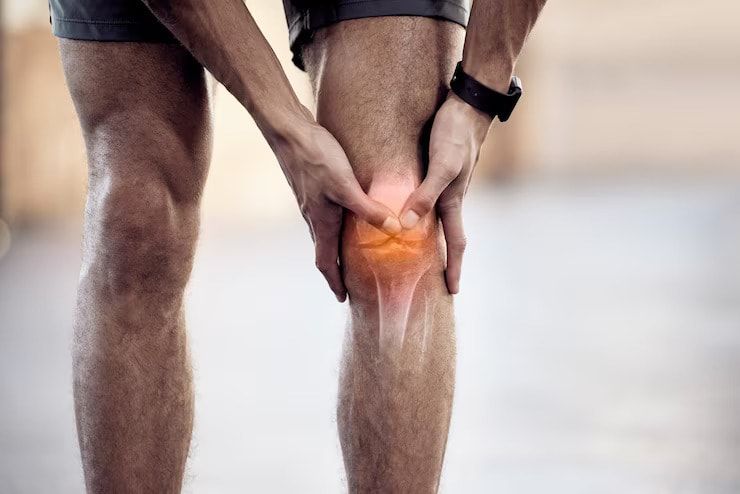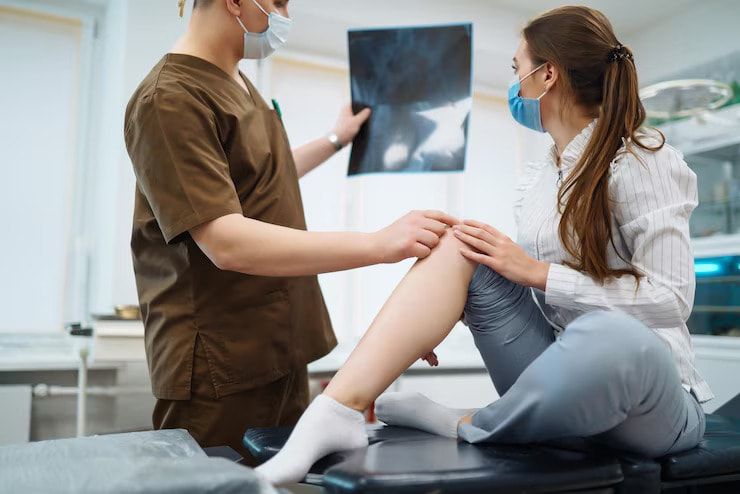Treatment of Patellar Tendinitis: What to Expect
By Louise YowPopularly known as, "Jumper's Knee," we can derive that this injury in the patellar tendon is mostly overuse and sports-related. How can we distinguish it exactly from normal knee pain or other injuries? We'll uncover everything about it in this article to determine the proper treatment of patellar tendinitis.

What Is Patellar Tendonitis or Jumper's Knee?
Patellar tendonitis (or tendinitis) is a common condition causing knee pain. It occurs due to inflammation of the patellar tendon, which connects your kneecap (patella) to your shinbone (tibia). This tendon plays a role in extending your knee during activities like jumping and running. If left untreated, it could lead to a tear or worse.
Who Gets Patellar Tendinitis?
Anyone can develop patellar tendinitis. Similarly, tendinitis can occur in other areas of your body, such as shoulders, elbows, and hips. Athletes who participate in sports involving repetitive jumping or running are more prone, thus the name "Jumper's Knee." People with tight hamstrings or weak quadriceps muscles are also at higher risk.
Truth is, there are limited treatment options for patellar tendonitis. Further research is needed to fully recommend the best treatment. However, rehabilitation programmes like physiotherapy helps with the management.
What Causes Patellar Tendinitis?
Repetitive stress or overuse on the patellar tendon is a major contributor to patellar tendinitis. This can happen due to certain activities or habits. Below are some examples:
- Overtraining during workouts, especially sudden increases in intensity or duration, can overload the tendon.
- Improper jumping or running form can place undue stress on the patellar tendon.
- Tight hamstrings pull on the kneecap, indirectly affecting the patellar tendon.
- Weak quadriceps muscles make it harder to absorb shock during jumping and running, putting extra strain on the tendon.
Complications of Patellar Tendinitis
Left untreated, patellar tendinitis can lead to chronic tendinopathy, a more severe condition with damaged tendon tissue and persistent patellar tendon pain. In rare cases, the tendon may even rupture completely.
Symptoms of Patellar Tendinitis
Individual experiences may vary when dealing with a jumper's knee. The most common symptom of patellar tendinitis is a dull ache or sharp pain just below the kneecap. It often gets worse during jumping, running uphill, or squatting. The area around the kneecap may also be tender to the touch.
Moreover, these symptoms may start as subtle and gradually worsen over time. You might initially notice a slight discomfort after a particularly intense workout, only to have it disappear with rest. However, as the inflammation progresses, the pain may become more persistent, even interfering with daily activities.
Some other signs of patellar tendonitis include:
- Stiffness in the knee, especially in the morning.
- A popping or snapping sensation in the knee.
- Weakness in the quadriceps muscles, which can affect your ability to straighten your leg completely
Seek medical advice if you suspect a patellar tendonitis from experiencing these signs. So, how is patellar tendonitis diagnosed exactly?
Diagnosis of Patellar Tendinitis

Patellar tendinitis clinical diagnosis usually involves different approaches. It usually starts with a physical exam by a doctor or sports medicine physician. You will discuss your symptoms in detail. This includes asking about your activity level, the nature of the pain (dull ache, sharp pain, etc.), and any recent injuries or activities that might have triggered the pain.
During the physical exam, your doctor will likely:
- Palpate (feel) your knee to assess tenderness and swelling around the patellar tendon.
- Test your knee joint range of motion by bending and straightening your knee.
- Perform specific tests to evaluate the strength and flexibility of your quadriceps muscles.
- In some cases, additional imaging tests might be necessary to rule out other potential causes of your knee pain. These may include:
- X-rays: Although X-rays don't directly visualize soft tissues like tendons, they can help identify bone abnormalities or fractures that might mimic patellar tendinitis symptoms.
- Ultrasound: This painless test uses sound waves to create an image of your knee joint, allowing visualization of the patellar tendon and potential tears or inflammation.
- MRI (Magnetic Resonance Imaging): An MRI provides detailed images of your knee, including the soft tissues like the patellar tendon and surrounding structures. This can be helpful in identifying small tears or other abnormalities within the tendon.
Following a thorough evaluation, your doctor will be able to confirm a diagnosis of patellar tendinitis and recommend the most appropriate treatment plan.
What Happens During Treatment?
Patellar tendinitis is usually treatable with conservative measures and passive treatments. Here's what you can expect when getting patellar tendonitis treated.
Medication
Over-the-counter pain relievers like ibuprofen or naproxen can help reduce pain and inflammation. But this alone is not enough for tendon healing.
Physiotherapy
Treatments like physiotherapy on knee pain is a common first approach in treating and rehabilitating knee injuries, especially in Singapore. Leading physical therapy providers like Phoenix Rehab will design a personalized treatment program, which may include:
- Soft tissue massage
- Manual therapy
- Targeted exercises
- Sports physical therapy
- Conventional electro-physiotherapeutic treatment
Surgery
In rare cases of severe patellar tendinitis or tendon rupture, surgery may be necessary for damaged tissue and tendon repair.
What You Can Do at Home
Several self-care strategies can aid your recovery alongside professional treatment:
- Pain Relievers: Over-the-counter pain relievers can offer short-term pain relief.
- Rest and Support: Reduce activities that aggravate your pain and consider using a patellar strap for additional support around the knee.
- Ice: Apply an ice pack to the affected area for 15-20 minutes at a time, several times a day, to reduce inflammation.
Tips for Your Doctor's Visit
Before seeing a doctor, here are convenient tips for a seamless visit:
- Make a list of your symptoms and how long you've been experiencing them.
- Write down any questions you have about patellar tendinitis and its treatment.
- Mention any medications or supplements you're currently taking.
Recovery Timeline
Healing time for patellar tendinitis varies depending on the severity of the condition and how well you adhere to treatment. Typically, it can take anywhere around three weeks for mild cases and three months for severe ones before you can return to normal physical activity.
You may still experience some knee pain after recovery, but nothing serious that physical therapy rehabilitation can't solve.
Preventing Patellar Tendinitis
To prevent patellar tendinitis (or its recurrence), consider these tips.
- Warm-up and Cool-down: Always warm up your muscles before exercise and cool down afterward to improve flexibility and reduce stress on your tendons.
- Gradual Progression: Increase workout intensity and duration gradually to avoid overloading your tendons.
- Strengthening Exercises: Regularly perform exercises to strengthen your quadriceps and core muscles
Other Treatment Options
While conservative treatments are usually successful, some healthcare professionals may explore other options for stubborn cases:
- Corticosteroid injections can provide powerful anti-inflammatory relief, but they should be used judiciously due to potential side effects like weakening the tendon.
- Extracorporeal Shockwave Therapy uses sound waves instead of invasive techniques to encourage healing in your tendon.
Physical Therapy Exercises
Physical therapy specializes in muscles, ligaments, tendons rehabilitation, which is applicable in managing patellar tendinopathy.
Here's a deeper dive into the types of exercises a physiotherapist might recommend:
Isotonic Exercise
These exercises involve lengthening and shortening muscles through a full range of motion. Examples include leg presses and controlled squats. Once pain subsides, these exercises can help rebuild strength and improve function.
Eccentric Loading
This type of exercise emphasizes the lengthening (eccentric) phase of muscle contraction. Studies have shown eccentric exercises to be particularly effective in reducing pain and improving tendon health.
Isometric exercise
This involves contracting a muscle group without any movement at the joint. It can help improve pain tolerance and provide a foundation for building strength. Moreover, isometric exercise induces analgesia and inhibition in patellar tendinopathy.
When to See a Doctor
While patellar tendinitis often responds well to conservative treatment, it's crucial to seek medical attention if you experience:
- Severe pain that interferes with daily activities
- Sudden swelling around the knee
- Inability to bend or straighten your knee
- Symptoms that persist despite several weeks of self-care
Conclusion
Patellar tendinitis can be a frustrating condition, but with proper treatment and rehabilitation, most people can achieve a full recovery and tendon healing. Noting the common causes, treatment options, and preventative measures can help you take control and maintain a healthy tendon.
Browse other articles by category
Physiotherapy for Knee Pain Physiotherapy For Slipped Disc Physiotherapy for Neck Pain PHYSIOTHERAPY
PHYSIOTHERAPY
 Hand Therapy
Hand Therapy
 Alternative
Alternative
 Massage
Massage
 Traditional Chinese Medicine Treatment
Traditional Chinese Medicine Treatment
 Rehab
Rehab
 Physiotherapy For Lower Back Pain
Physiotherapy For Shoulder Pain
Orthopedic Doctors, Insurance & Healthcare
Physiotherapy For Upper Back Pain
Frozen Shoulder
Physiotherapy for Back Pain
Physiotherapy For Lower Back Pain
Physiotherapy For Shoulder Pain
Orthopedic Doctors, Insurance & Healthcare
Physiotherapy For Upper Back Pain
Frozen Shoulder
Physiotherapy for Back Pain

 Whatsapp us now
Whatsapp us now